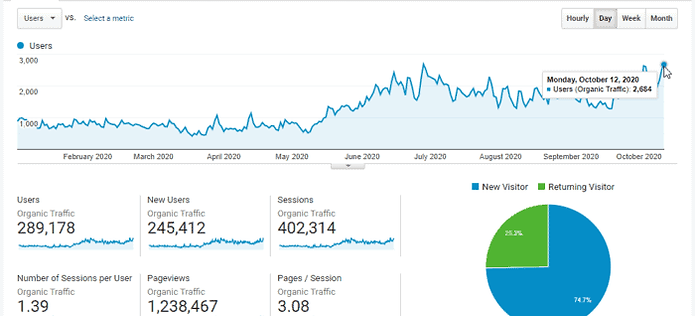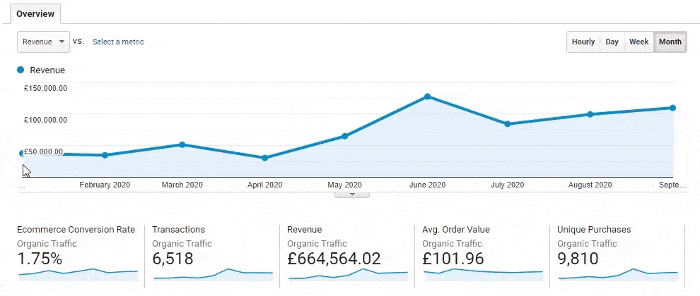𝗧𝗵𝗶𝘀 C𝗮𝘀𝗲 𝘀𝘁𝘂𝗱𝘆 we are 𝗽𝗮𝗿𝘁𝗶𝗰𝘂𝗹𝗮𝗿𝗹𝘆 𝗽𝗿𝗼𝘂𝗱 𝗼𝗳 𝗯𝗲𝗰𝗮𝘂𝘀𝗲 𝗼𝗳 𝗵𝗼𝘄 𝗺𝘂𝗰𝗵 𝘄𝗲 𝗵𝗮𝗱 𝘁𝗼 𝗼𝘃𝗲𝗿𝗰𝗼𝗺𝗲! 𝗣𝗹𝗲𝗮𝘀𝗲 𝗖𝗵𝗲𝗰𝗸𝗼𝘂𝘁 𝘁𝗵𝗲 𝗳𝘂𝗹𝗹 𝗖𝗮𝘀𝗲𝘀𝘁𝘂𝗱𝘆

How we Tripled our Client’s Ecommerce Revenue with SEO: A Success Story
✅𝗜𝗻𝗰𝗿𝗲𝗮𝘀𝗲 𝗱𝗮𝗶𝗹𝘆 𝘀𝗲𝗮𝗿𝗰𝗵 𝘁𝗿𝗮𝗳𝗳𝗶𝗰 𝗳𝗿𝗼𝗺 𝟵𝟰𝟬 𝘁𝗼 𝟮,𝟲𝟴𝟰
✅ 𝗜𝗻𝗰𝗿𝗲𝗮𝘀𝗲 𝗺𝗼𝗻𝘁𝗵𝗹𝘆 𝘁𝗿𝗮𝗻𝘀𝗮𝗰𝘁𝗶𝗼𝗻𝘀 𝗳𝗿𝗼𝗺 𝟯𝟵𝟰 𝘁𝗼 𝟭,𝟬𝟮𝟴
✅𝗜𝗻𝗰𝗿𝗲𝗮𝘀𝗲 𝗺𝗼𝗻𝘁𝗵𝗹𝘆 𝗿𝗲𝘃𝗲𝗻𝘂𝗲 𝗳𝗿𝗼𝗺 £𝟯𝟳,𝟰𝟱𝟭 𝘁𝗼 £𝟭𝟬𝟵,𝟯𝟳𝟳 (£𝟭𝟮𝟳,𝟮𝟲𝟲 𝗮𝘁 𝗽𝗲𝗮𝗸)
Which perfectly positions them for success as we move into the golden quarter this year.

𝗛𝗼𝘄 𝗱𝗶𝗱 we 𝗮𝗻𝗱 the 𝘁𝗲𝗮𝗺 𝗮𝘁 𝗧𝗮𝗿𝗴𝗲𝘁 𝗚𝗲𝗻𝗶𝘂𝘀 𝗱𝗼 𝘁𝗵𝗮𝘁?
Well, keep reading and we’ll break down the complete strategy for you step by step!
A Closer Look At The Case Study Site
The client is an ecommerce site in the sports industry that competes against many household names.
This wasn’t helped by Covid, especially after the lockdown announcement in March.
So we spent the first part of the year making sure the site was in the right position to benefit when lockdown restrictions were lifted.
𝗧𝗵𝗶𝘀 𝗶𝘀 𝘄𝗵𝗮𝘁 𝗶 𝗱𝗶𝗱
✅𝗔𝗻𝗮𝗹𝘆𝘇𝗲𝗱 𝘁𝗵𝗲 𝗰𝗼𝗺𝗽𝗲𝘁𝗶𝘁𝗶𝗼𝗻
✅𝗖𝗼𝗺𝗽𝗹𝗲𝘁𝗲𝗱 𝗮 𝘁𝗲𝗰𝗵𝗻𝗶𝗰𝗮𝗹 𝗦𝗘𝗢 𝗮𝘂𝗱𝗶𝘁
✅ 𝗙𝗶𝘅𝗲𝗱 𝗮𝗹𝗹 𝗼𝗳 𝘁𝗵𝗲 𝗽𝗿𝗼𝗯𝗹𝗲𝗺𝘀 𝘄𝗲 𝗳𝗼𝘂𝗻𝗱
✅𝗔𝗻𝗱 𝗰𝗹𝗲𝗮𝗻𝗲𝗱 𝘂𝗽 𝘁𝗵𝗲 𝗹𝗶𝗻𝗸 𝗽𝗿𝗼𝗳𝗶𝗹𝗲
But it wasn’t quite as easy as that because the site presented several challenges that we are going to talk you through below.
Challenges we Had To Overcome
The sports niche is a competitive niche with well-established brands with big-budgets dedicated to their marketing campaigns and website.
However, this isn’t the first time we have had to overcome such problems.
In this case, our main goals were to rank for the specific brands our client sells by building a cleaner on-page structure focused on driving authority to the top converting pages.
But when we first took the site on there were a number of problems to deal with like:
❌ Low-quality link profile
❌ Poor internal linking
❌ Missing and/or duplicate content
❌ Poor keyword research
❌ Weak on page optimisation
Plus – the website wasn’t particularly user friendly either which led to poor bounce rates, engagement and conversion. Interested in ecommerce? Check out these ecommerce statistics.
Creating A Plan Of Attack
So with an uphill battle ahead of us… …we put a 6 step strategy in place to guide us to search success!
𝗦𝘁𝗲𝗽 #𝟭 – 𝗕𝗮𝗰𝗸𝗹𝗶𝗻𝗸𝘀
Based on client feedback, the first thing we looked at was the backlink profile.
Ideally we like to see relevant links with a healthy mix of exact match, partial match, branded and generic anchor text.
But our client had a 𝗰𝗹𝘂𝘁𝘁𝗲𝗿𝗲𝗱 𝗯𝗮𝗰𝗸𝗹𝗶𝗻𝗸 𝗽𝗿𝗼𝗳𝗶𝗹𝗲 with many domains that were not only irrelevant but very low in their quality.

To combat this problem, incremental updates to the disavow files were made in March, April, June and July on all variations of the client’s domain in Google Search Console.
This helped us to 𝗲𝘅𝗰𝗹𝘂𝗱𝗲 𝘁𝗵𝗲 𝘁𝗼𝘅𝗶𝗰 𝗹𝗶𝗻𝗸𝘀 Google associated with the client.
i 𝘀𝗽𝗲𝗰𝗶𝗳𝗶𝗰𝗮𝗹𝗹𝘆 𝗹𝗼𝗼𝗸𝗲𝗱 𝗳𝗼𝗿:
➡️𝗗𝗼𝗺𝗮𝗶𝗻𝘀 𝘄𝗶𝘁𝗵 𝗻𝗼 𝗮𝘂𝘁𝗵𝗼𝗿𝗶𝘁𝘆.
➡️ 𝗧𝗮𝗿𝗴𝗲𝘁𝗲𝗱 𝗮𝗻𝗰𝗵𝗼𝗿 𝘁𝗲𝘅𝘁.
➡️ 𝗧𝗼𝘁𝗮𝗹 𝗻𝘂𝗺𝗯𝗲𝗿 𝗼𝗳 𝗯𝗮𝗰𝗸𝗹𝗶𝗻𝗸𝘀 𝗳𝗿𝗼𝗺 𝗮𝗻𝘆 𝘀𝗶𝗻𝗴𝗹𝗲 𝗱𝗼𝗺𝗮𝗶𝗻.
➡️ 𝗧𝗿𝗮𝗳𝗳𝗶𝗰 𝘀𝘁𝗮𝘁𝗶𝘀𝘁𝗶𝗰𝘀 𝗼𝗳 𝘁𝗵𝗼𝘀𝗲 𝗱𝗼𝗺𝗮𝗶𝗻𝘀 𝗹𝗶𝗻𝗸𝗶𝗻𝗴 𝘁𝗼 𝘁𝗵𝗲 𝗰𝗹𝗶𝗲𝗻𝘁’𝘀 𝗱𝗼𝗺𝗮𝗶𝗻.
As we were cleaning existing backlinks (Learn how to disavow backlinks), we were also building new relevant and autoreactive links whilst also taking care of
Step #2 – On-Page SEO
During our analysis we found that competitors category pages were ranking almost at will, but our clients category pages were not.
Why?
Because competitors were including complementary excerpts of text on their category pages to supplement the products listed on the page.
This was a small but crucial difference that were allowing competitors to clean up.
Adding content to your category pages is essential for 2 reasons: They provide context to the user in terms what or how to buy.
They help search engines to establish the topical relevance they need. In some cases our client had added keyword stuffed content to category pages previously, but it was hidden and way over-optimized by today’s SEO standards.

So instead we replaced all of that with content that assists people’s buying decisions with internal links to key pages, brands and products placed accordingly.
Then, we let the products on the page do the rest of the talking.
Step #3 – Internal Anchor Text Optimization
The client was not making the best use of internal anchor text opportunities.
In most cases they were linking to category, sub-category and product pages with generic anchor text like-
❌ See More
❌View Now
❌ Click Here
But internal linking is one of the 𝗺𝗼𝘀𝘁 𝗽𝗼𝘄𝗲𝗿𝗳𝘂𝗹 𝘁𝗮𝗰𝘁𝗶𝗰𝘀 𝗶𝗻 𝗘𝗰𝗼𝗺𝗺𝗲𝗿𝗰𝗲 𝗦𝗘𝗢
Step #4 – Technical Fixes & Implementation
Our technical SEO audit found a number of fundamental problems that we needed to fix in order to create a well-oiled site.
This included problems like-
✅Adding relevant ALT tags
✅Fixing internal 301 redirects
✅Taking care of all 4XX errors
✅ Updating duplicate meta data And so forth!
Although many of these are low level problems, lots of small problems quickly add up to a big problem so it’s important to take care of these as you find them.
we also worked to increased website speed across the board-
Step #5 – Page Titles
One of the biggest weaknesses of the site was that the page titles were not including target keywords to cement the purpose of the page.
Ideally you want to do this as close to the start of the title tag as possible-
But this wasn’t the case for this client.
Instead they were using title tags that looked like-
Brand Name | Online Sports Shop | Order Now | Partial Match Keyword
Which left an awful lot of room for opportunity! So we went through the entire site and updated titles to be keyword focused with SEO copywriting in mind.
Step #6 – Heading Tags
Like title tags, the use of heading tags throughout the site was also problematic.
Not only was the structure often wrong, but they were under utilizing the opportunities a correct header structure presents-
We went through each page and updated the header structure to be correct and to also increase the overall net of relevant keywords we captured.
This also helped to establish topical relevance, reduce cannibalization across the site and streamline the customer journey.
The Results Are In

And that is despite the fact they have had to fight off Covid lockdowns that had a huge impact across the sporting sector.
But more important than traffic growth, is revenue growth-

Which especially impressive given the competitive nature of the niche and the uphill battle we faced with lockdowns and the economy.
This is a case study we are particularly proud of because of how much we had to overcome!


